Mary Quattlebaum's Blog, page 2
April 22, 2019
The Roots of Rap
by Karen Leggett Abouraya
There is probably a tapper in your home or class: the boy or girl who is constantly tapping, often unconsciously, with pencil or thumbs or toes. Rhythm pulses through their bodies like strikes of lightening - like spoken word poetry – like rap – like the poetry of Carole Boston Weatherford’s new book, The Roots of Rap: 16 Bars on the 4 Pillars of Hip-Hop.
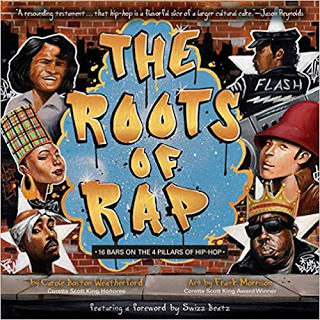
Hip-hop, explains Weatherford, “is a form of youth expression that originated in New York City in the late 1970s and included four pillars: graffiti, break dancing, rapping/MCing, and DJing/scratching/turntablism.” Rap, “the spoken or chanted rhyming lyrics performed to a beat.”
With illustrations by Frank Morrison that jump and jam on every page, The Roots of Rap celebrates the loud, boisterous original culture of hip-hop, giving young people an opportunity to write and contemplate in ways they might not have thought were acceptable in a classroom.
Look at Weatherford’s list of “Hip Hop Who’s Who.” · Which musicians do you know and like?· Pick two musicians and compare and contrast their music.· Create a hip-hop name for yourself and explain it.
Of course read the book out loud. Very loud. · What graffiti message would you like to paint on a wall? (Is there a classroom bulletin board for all the student messages?)· How do Morrison’s illustrations amplify and strengthen the text?· Why makes rap and hip-hop poetry so powerful – and lasting?

Of course you can plan a classroom hip-hop party, with plenty of music and everyone writing a poem that they are proud to stand up and say or sing.
“From Atlanta to Zanzibar, youth spit freestyle freedom sounds. Hip-hop is a language that’s spoken the whole world ‘round.”
And please celebrate Carole Boston Weatherford as the 2019 Children’s Book Guild Nonfiction Award winner on May 11 in Washington, D.C.
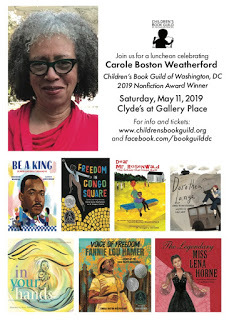
Published on April 22, 2019 13:30
April 8, 2019
I Call Dibs!
by Laura Gehl
Dibs, written by Laura Gehl and illustrated by Marcin Piwowarski, is the story of two brothers. Julian calls “dibs” so frequently that his baby brother Clancy ends up saying “dibs” as his very first word. Things get out of control when Clancy starts calling dibs on a bakery, an airplane, and even the White House! But when Clancy gets trapped in space, it is Julian who needs to harness the power of dibs to rescue his little brother.
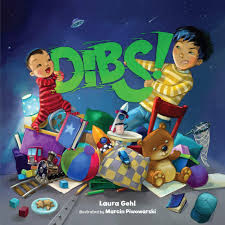
After reading Dibs out loud, try these writing activities with your students:
1. If you could call dibs on ANYTHING, the way Clancy does, what would you call dibs on? Why?
2. Julian gets frustrated when Clancy doesn’t follow the “rules” of Dibs. Even though these rules are not written down, most kids know you can call dibs on the biggest cookie but not on a whole bakery. You can call dibs on sitting in the window seat in an airplane, but you can’t call dibs on a whole airplane. Think about rules in your life. What rules at home or school do you wish you could break? What rules do you wish other people followed? Do you have a sibling, cousin, or friend who breaks rules? How do you feel about that when it happens?
3. Some kids who read the book Dibs already know the expression “calling dibs,” and some kids have never heard the expression before. Make a list of expressions that you know. Which of these expressions do you actually use when you talk to your friends?
4. Look at your list of expressions that you know from #3. Can you imagine how a kid could take one of those expressions too far, the way Clancy takes dibs too far in the book Dibs? How could you turn that into a story? For example, think about the expression “An apple a day keeps the doctor away.” What if a kid decided that she would eat ten apples—or a hundred apples—or a thousand apples—every day so that she would never, ever get sick? And then she ate so many apples that it actually made her sick! Or maybe she turned into an apple and then her grandma wanted to turn her into apple pie! Take one of the expressions from your list and write a story in which a kid takes the expression too far.
 Bio: Laura Gehl is the author of picture books including One Big Pair of Underwear (Charlotte Zolotow Highly Commended Title, International Literacy Association Honor Book, Booklist Books for Youth Editors’ Choice); Hare and Tortoise Race Across Israel, And Then Another Sheep Turned Up, and Koala Challah (all PJ Library selections); the Peep and Egg series (Parents’ Choice Recommendation, Amazon Editors’ Pick, Children’s Choice Book Award Finalist); My Pillow Keeps Moving (Junior Library Guild selection, NYPL Best Books of 2018 selection); and I Got a Chicken for my Birthday (Kirkus Best Picture Books of 2018 selection). 2019 releases include Except When They Don’t (Little Bee), Dibs! (Lerner), Juniper Kai: Super Spy (Two Lions); Judge Juliette (Sterling); Always Looking Up: A Story of Astronomer Nancy Grace Roman (Whitman); and the Baby Scientist series (HarperCollins). Laura lives in Chevy Chase, Maryland, with her husband and four children. Visit her online at www.lauragehl.com.
Bio: Laura Gehl is the author of picture books including One Big Pair of Underwear (Charlotte Zolotow Highly Commended Title, International Literacy Association Honor Book, Booklist Books for Youth Editors’ Choice); Hare and Tortoise Race Across Israel, And Then Another Sheep Turned Up, and Koala Challah (all PJ Library selections); the Peep and Egg series (Parents’ Choice Recommendation, Amazon Editors’ Pick, Children’s Choice Book Award Finalist); My Pillow Keeps Moving (Junior Library Guild selection, NYPL Best Books of 2018 selection); and I Got a Chicken for my Birthday (Kirkus Best Picture Books of 2018 selection). 2019 releases include Except When They Don’t (Little Bee), Dibs! (Lerner), Juniper Kai: Super Spy (Two Lions); Judge Juliette (Sterling); Always Looking Up: A Story of Astronomer Nancy Grace Roman (Whitman); and the Baby Scientist series (HarperCollins). Laura lives in Chevy Chase, Maryland, with her husband and four children. Visit her online at www.lauragehl.com.
Published on April 08, 2019 14:00
March 25, 2019
Words Have Power
by Karen Leggett Abouraya
“Let us pick up our books and pens…One child, one teacher, one pen, and one book can change the world.” United Nations, July 12, 2013
The words of Malala Yousafzai, the Pakistani teen shot for defending the right of all children to be educated, have echoed around the world. She continues to travel and speak out, highlighting the dim future for girls forced to leave school early and children forced to flee their homes.

The new edition of Malala Yousafzai: Warrior with Words (2019, Lee & Low) tells Malala’s story from the blog she began writing for the BBC at age 11 to her Nobel Prize in 2014 and the organizations she continues to inspire as a 21-year-old college student.
When she returned from her Girl Power Trip around the world in 2017, she said she “wants every girl and boy to stand up and speak out for the millions of children worldwide who are not yet able to attend school.” The book includes extensive back matter on Pakistan, the Taliban, the Malala Fund and other organizations young people can join to support the cause of global education for all.
Malala Yousafzai: Warrior with Words is a perfect launchpad for children from elementary school even through high school to think and write about civic engagement, as well as their own lives contrasted with Malala and the children for whom she advocates. Here are a few suggestions:
· Malala was forced to flee her own home with just a small backpack when the Pakistani Army began fighting the Taliban. Aside from whatever food and clothes you could carry, what three things would you take if you had to leave your home suddenly and why? (Give this assignment very carefully if there are children in your class who may actually have experienced such displacement.)
· Children have an immediate understanding of things that are not fair. Have them write about something in their school or community that is unfair – and what they could do about it.
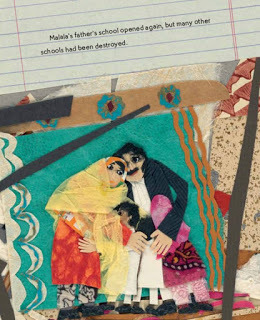
· For an art project, have students consider this illustration showing Malala’s family when they returned to their town after it had been heavily damaged by fighting. Illustrator Susan L. Roth says she is not precise in her art, which she makes with paper, fabric and other “found” objects. But the emotions in this illustration are very clear. What is the family feeling? Ask students to use paper and found objects to make a portrait showing an emotion.
· Older students may scoff at the idea of reading a picture book, but they too can write about how illustrations help tell the story (visual literacy). Students can also react to the ideas in this Washington Post article about the moral authority of children – including Malala. Why do her ideas resonate? Why do students think protests, marches and other civic action by children have a greater impact than actions by adults (or not)?
· A long-term project: Identify an issue or cause that is supported by the majority of students in class and talk about ways to make the change they would like to see. Write letters to the appropriate authority, design flyers and write online messages to spread the word.
Malala rarely draws attention to herself when she speaks. When she accepted the Nobel Prize, she said, “This award is…for those forgotten children who want education. It is for those frightened children who want peace. It is for those voiceless children who want change.”
Indeed, says the young warrior with words, “our words can change the world.”
Published on March 25, 2019 14:00
March 11, 2019
Traveling Back in Time
guest post by Deborah Kalb
What would it be like to travel back in time and meet the early presidents and their families? That’s what the fifth graders in George Washington & the Magic Hat and its sequel, John Adams & the Magic Bobblehead, get to do.

Sam and Ava are regular 21st century kids, living across the street from each other in Bethesda, Maryland, dealing with issues a lot of kids face. Sam and his former best friend, Andrew, aren’t speaking to each other any more. Ava, in a newly blended family, can’t stand her stepbrother, J.P.

And then, thanks to a crotchety hat, in Sam’s case, and a talking bobblehead, in Ava’s, they are transported into a completely different time.
Students can focus on the historical figures--George Washington, John and Abigail Adams, and more. What do they know about the Founding Fathers and Mothers? Is there one that they’re particularly interested in and why? What do they think these historical figures would make of today’s world if the time travel were reversed?
And then there are the contemporary issues. How do the students identify with Sam? With Ava? How do the students try to resolve the issues that bother them?
If they had a magic hat or a magic bobblehead, which time period would they like to visit, and why? Is there a particular person they’d like to get to know?
Any of these questions can prompt a discussion or writing assignment that will get students thinking about history or today’s issues or a combination of both.
Here are links to George Washington’s home, Mount Vernon, in Northern Virginia, and to the Adams National Historic Park in Quincy, Massachusetts.
 Deborah Kalb is a freelance writer and editor. She spent two decades working as a journalist in Washington, D.C., for news organizations including Gannett News Service, Congressional Quarterly, U.S. News & World Report, and The Hill, mostly covering Congress and politics. Her book blog, Book Q&As with Deborah Kalb, which she started in 2012, features hundreds of interviews she has conducted with a wide variety of authors. She is the author of the new children’s book The President and Me: John Adams and the Magic Bobblehead (Schiffer, 2018), the second in a series — after The President and Me: George Washington and the Magic Hat (Schiffer, 2016) Visit http://www.deborahkalb.com/
Deborah Kalb is a freelance writer and editor. She spent two decades working as a journalist in Washington, D.C., for news organizations including Gannett News Service, Congressional Quarterly, U.S. News & World Report, and The Hill, mostly covering Congress and politics. Her book blog, Book Q&As with Deborah Kalb, which she started in 2012, features hundreds of interviews she has conducted with a wide variety of authors. She is the author of the new children’s book The President and Me: John Adams and the Magic Bobblehead (Schiffer, 2018), the second in a series — after The President and Me: George Washington and the Magic Hat (Schiffer, 2016) Visit http://www.deborahkalb.com/
Published on March 11, 2019 14:00
February 25, 2019
Book Gardens
Guest Post byRashin Kheiriyeh
“Nestled in the branches of a tree,Arlo opened his book and breathed in.
“Beginnings were always the best part.They smelled as if anything were possible.”
I illustrated The Book Tree, written by Paul Czajak – a wonderful story about a boy who sits on the branches of a tree to read. When one of his books falls on the Mayor’s head, the Mayor decides to tear up every book in town – with disastrous consequences for teachers and their students, chefs and their restaurants, actors and their theatres and of course, libraries.

But then there was a miracle: “a sprout springing from where the page had been buried. It began to open its leaves. It reached for Arlo’s words, begging for more.” Pretty soon, Arlo was imagining and writing stories about giants and swans and fire-breathing beasts.
“People grew hungry for reading again. Some wrote their own stories and became book gardeners themselves.”
Even the Mayor finally shared the wonder of books.
My illustrations feature oil paint, ink and collages. I used natural materials to bring depth and contrast to my drawings, like using real feathers, pieces of wood, fabrics and metals to make the collages more tangible.
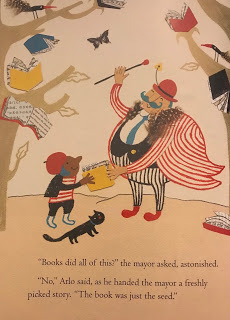
People of the town have different skin tones with blue hair or mustaches. They look funny and whimsical. The book tree itself is been printed with golden ink to give it a magical shine. The books that actually grow on the tree branches are in different languages.
The Book Tree can inspire student writing and even turn a whole school into book gardeners – limited only by your imagination.
Here are a few ideas to get started: 1 – Have students draw a book tree full of their favorite books.2 – The teacher can draw a tree and each student draw or attach his/her favorite book to it. 3 – Draw the Mayor and Arlo as friends, reading a book together – or have students write a paragraph about what books the Mayor and Arlo enjoyed reading together. Perhaps they could even write a story together.4 – Look at the illustrations in the book and find places where materials other than paint and paper have been used. Make your own collage with lots of different materials.
The motto of publisher Barefoot Books is to “step inside a story.” What stories would your students like to step inside? The Book Tree celebrates the themes Barefoot Books seeks to highlight: “encourage independence of spirit, enthusiasm for learning and respect for the world’s diversity.”
www.rashinart.com
Published on February 25, 2019 14:00
February 11, 2019
Read Africa
by Karen Leggett Abouraya
How often do you make a list for the grocery store and then leave the list at home and have to remember what you wrote down? That is Fatima’s dilemma in Grandma’s List, a Children’s Africana Book Award winner by Portia Dery, illustrated by Toby Newsome.
 Calling Grandma’s List an excellent read-aloud book, Africa Access Review says the illustrations “show a neighborhood in Ghana that is very typical of many African towns with shops, gardens, small livestock, and many people outside working and playing. Children not familiar with West Africa can learn about palm nut soup, groundnuts (peanuts) and Bissap drink.”
Calling Grandma’s List an excellent read-aloud book, Africa Access Review says the illustrations “show a neighborhood in Ghana that is very typical of many African towns with shops, gardens, small livestock, and many people outside working and playing. Children not familiar with West Africa can learn about palm nut soup, groundnuts (peanuts) and Bissap drink.”
Africa Access highlights the best books about Africa especially during its February Read Africa initiative but throughout the year as well.
Fatima has convinced her grandmother she can help with the chores on Grandma’s list of errands – but she loses the list and has to remember all the details, mixing up just about everything. Contrary to expectations, Fatima’s family is very forgiving and she concludes that being a child isn’t so bad after all.
This is an excellent book for children to study the illustrations:· How does the dinner table look the same as yours? Different?· What about the village scene – what looks familiar? Can you draw a picture of your neighborhood on a Saturday morning?· Have children write their own list of grocery items or household tasks and imagine they lost the list. Ask them to write a paragraph about how they could help themselves remember items without that list. · Encourage children to consider the importance of details. Find out about cornflour – the kind Fatima mistakenly purchased – and write a paragraph about how it is used differently from wheat flour. Try to find a Ghanaian recipe using cornflour (usually called cornstarch in the United States).· Fatima doesn’t like her nickname “Fati.” Do you have a nickname you like – or don’t like? Write about your nickname – or a nickname you would like to have.
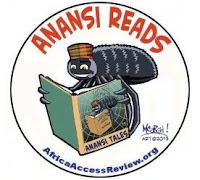 There are more classroom ideas in the Africa Access Review of
Grandma’s List
as well as recommended picture books (Anansi Reads) and chapter books (Sankofa Reads), book marks and reviews of Children’s Africana Book Award winners.
There are more classroom ideas in the Africa Access Review of
Grandma’s List
as well as recommended picture books (Anansi Reads) and chapter books (Sankofa Reads), book marks and reviews of Children’s Africana Book Award winners. Children and teachers may add their own comments about the books they read at http://africaaccessreview.org/ - which becomes a student writing activity in itself. It is also possible for students to submit videos or posters about the books they read, write a letter to the author or illustrator and even request a visit from a Read Africa Teaching Artist.
The 2018 CABA awards will be celebrated with a reception on April 5 and a family festival April 6 at the Smithsonian National Museum of African Art in Washington, D.C.
Published on February 11, 2019 14:00
January 28, 2019
An Amazing Classroom Resource!
by Jacqueline Jules
Where can a teacher easily find interesting pieces to share in the classroom? Look no further than Issue 8 of Balloons Lit. Journal.

This magazine for upper elementary and middle school students is an amazing resource of poetry, fiction, and art. What’s more, it includes contributions from all over the world and features student work alongside professional adults. Poems are attractively presented in full page layouts sure to inspire the imagination. I am thrilled that one of my poems, “Egret” appears on page 41.

I wrote “Egret” while I was out on a brisk walk near a body of water and this beautifully immobile creature stopped me in my tracks. Ask your students to describe an animal or plant so enchanting they couldn’t help but pause for a moment to gaze. Better yet, take your students outside and ask them to stand silently for five minutes, watching the natural world. What did they see, hear, smell? How did they feel? Can they make an effort to pay attention to the grass, the trees, the clouds, the insects, and everything else which flutters unnoticed when we hurry too much? Mindfulness can enrich one’s life as well as one’s writing.
Listening to an author read their own work can be a meaningful experience for students. Balloons Lit. Journal also offers audio clips on selected pieces. Scroll down the page where Issue 8 appears and you will see an audio section and an opportunity to hear me read my poem, “Egret” as well as three other poets in this issue.
I highly recommend sharing 14 year old Braxton Schieler’s voice reading his work, “Someday I’ll Be—An Autobiography.” Braxton writes about his life from the age of three till an imagined old age, describing emotional transitions with clarity and insight. Hearing a student read his own personal narrative aloud should jump start many a reluctant pen in your classroom.
Other pieces in Balloons Lit. Issue 8, such as the poems, “I Think My Teacher is a Witch” and “Pillow Problems” could be great models for humorous writing.
Finally the artwork in Balloons Lit. Issue 8 is stunning. Available in PDF form on the website, images could be projected to present the ekphrastic challenge of providing a written response to and/or description of artwork.
Don’t miss this amazing resource for the classroom! Check out Issue 8 of Balloons Lit. Journal today!
www.jacquelinejules.com
Published on January 28, 2019 14:00
January 14, 2019
Capturing Black and White America
by Karen Leggett Abouraya
“The youngest of fifteen, Parks arrives stillbornAnd is nearly left for dead until a dipIn ice water shocks his tiny heart to beat.
The baby is named for the man who saved his life, Dr. Gordon.”

Gordon Parks would grow up to become a professional photographer, cataloging American life on film for the Farm Security Administration, Office of War Information, Standard Oil, Ebony, Vogue, Fortune and Life.
His early work (1940-50) is the focus of an exhibition at the National Gallery of Art in Washington, D.C. from November 4, 2018 until February 18, 2019. He is also the subject of Carole Boston Weatherford’s biography, Gordon Parks: How the Photographer Captured Black and White America.
For Gordon Parks, photography was the tool he used to expose “the unfairness of segregation,” and the African American struggle against racism. “He not only documented but also served as an advocate for the Civil Rights Movement.”

Parks photographs often featured everyday Americans in their daily lives, including cleaning woman Ella Watson – a photo that became known as American Gothic. “In one iconic photo,” writes Weatherford, “Parks conveyed both the African American struggle against racism and the contradiction between segregation and freedom.”
“Standing before the flag of freedom,cleaning lady Ella Watsonholds the tools of her tradeand the hopes of her grandchildren.”
· Ella Watson lived in Washington, D.C. in the 1940s. · What do you think she hoped for her grandchildren? For students whose grandparents are living, have them find out their hopes for their grandchildren. Write about it or share those hopes with the class. Students can also imagine what they might hope for their own children. · Ask students to write about three things in their own daily lives that they would photograph – and why they selected these people, events or places. · Perhaps a few single use cameras could be purchased to enable students to photograph a story about their school that could be published online, in the school newspaper or in a local community newspaper. (This would be an opportunity for students to learn about obtaining the rights to print photographs of other people.)
Parks was not only a photographer. He wrote a novel, directed a film and wrote poetry and music as well.
· If you wanted to change people’s minds about an issue in society, what do you think would be the best medium and why? Gordon Parks is one of many famous Americans profiled by Carole Boston Weatherford. She is the 2019 Children’s Book Guild Nonfiction Award winner and will speak in Washington at the award celebration on May 11, 2019. Make plans to come and hear what she has to say – students welcome!
Published on January 14, 2019 14:00
January 1, 2019
HAPPY NEW YEAR! HAPPY NEW YEAR!
Guest Post by Susan Roth
Many Americans welcome the new year with parties, fireworks, feasts and champagne at midnight. And what do we do the morning after? We make lists of New Year’s resolutions. Do we keep them? Well, we try.
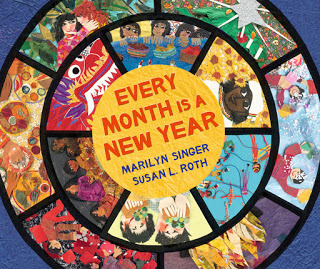
New Year’s Day is our once-a-year-day for a clean slate, yet another chance to do better and be better. On New Year’s Day everyone is full of good intentions.
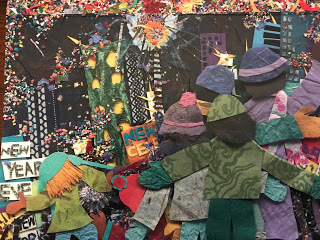 New Year's Eve in NYC, Illustration Susan L. RothDiets and exercise usually top the list, but really, lists can go on and on and on: Read more good books, work harder, work longer, be more polite, stop being impatient. No more bad words, go to sleep earlier, get up earlier, hang up clothes instead of dropping them on the floor! Be better! Be nicer! Be more generous! Be more appreciative! Be a better friend! Be a better neighbor! Be tolerant, be understanding, be kind, be GOOD!
New Year's Eve in NYC, Illustration Susan L. RothDiets and exercise usually top the list, but really, lists can go on and on and on: Read more good books, work harder, work longer, be more polite, stop being impatient. No more bad words, go to sleep earlier, get up earlier, hang up clothes instead of dropping them on the floor! Be better! Be nicer! Be more generous! Be more appreciative! Be a better friend! Be a better neighbor! Be tolerant, be understanding, be kind, be GOOD!
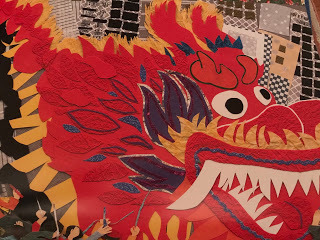 Chinese New Year, Illustration Susan L. RothOnce the list is begun, it can quickly fill the page, and usually the list is adhered to, at the beginning, anyway. But what if we were given a plethora of second chances for celebrations as well as for second chances to improve ourselves?
Chinese New Year, Illustration Susan L. RothOnce the list is begun, it can quickly fill the page, and usually the list is adhered to, at the beginning, anyway. But what if we were given a plethora of second chances for celebrations as well as for second chances to improve ourselves?
Every Month is a New Year, (Lee and Low, 2017) a book of poems by Marilyn Singer, illustrated by me, is a book full of Happy New Year celebrations from all over the world. I learned so much from making the pictures for this book: there are no two even similar looking. And as for resolutions, every page turn affords a fresh start.
 Muslim New Year, Illustration Susan L. RothHerewith I am presenting you with another big list full of related activities for students, at least enough for an entire happy new year.
Muslim New Year, Illustration Susan L. RothHerewith I am presenting you with another big list full of related activities for students, at least enough for an entire happy new year.
1-Ask students to write a short piece about the new year celebrations that they enjoy in their own families.
2-Suggest that they create an accompanying illustration. My favorite medium is collage, but they should choose their own favorite.
3-For the most energized, curious and adventurous students: let them try to find other new year celebrations not mentioned in Every Month Is A New Year that they can write about and illustrate.
4- Invite your group to make a joint project calendar of happy new year illustrations which could certainly begin in February or March. Pictures would not have to correspond with unusual-to-us month-specific celebrations, but rather, personal ones. If there are more than a calendar year's worth of students in your group, continue the calendar for as many months as there are students. The finished product could be presented as a big wall of illustrations as well as a calendar, designed to fill a bulletin board, and/or it could be a consecutive band of illustrations designed to go around the walls of a classroom.
5-Encourage each student to start his/her own list of resolutions. Designate one day every month for looking back to see how they did. Invite anyone who managed to keep his/her resolution for that month to give a 30 second speech telling about it. Was it easy? hard? worth the effort? Does the student feel proud and victorious? Take time for applause!
Do the same for anyone who wishes to tell about failing in the attempt, with applause for the courage it takes to speak about the failure. (This should be handled with humor).
6-Encourage a designated time, probably monthly, to look into each of the cultures explored in Every Month Is A New Year. The back matter in the book includes great explanations and resources for each holiday. For example: make a dragon; watch wheat grass grow fast daily, right before everyone's very eyes, in a little dish in the classroom; make a kite and fly it; eat green grapes. With permission and supervision, break pots. (Do skip fireworks and firecrackers).
7-Maybe you could even create a brand new holiday: Happy New Month! Let it include a short monthly LITTLE party, and don't forget the Happy New Month's resolutions.
8-Finally, here are some heavier thoughts to think about, write about, to illustrate.
Encourage everyone, including teachers and librarians, to think about the concept and idea of starting new, starting over. Why is the possibility of one more chance to BE better and to DO better so important? Does hope REALLY spring eternal? And why do we have celebrations anyway? for incentives? for rewards? just because they are fun?
I hope this food for thought gives you something to ponder all year long.
http://susanlroth.com/
Many Americans welcome the new year with parties, fireworks, feasts and champagne at midnight. And what do we do the morning after? We make lists of New Year’s resolutions. Do we keep them? Well, we try.

New Year’s Day is our once-a-year-day for a clean slate, yet another chance to do better and be better. On New Year’s Day everyone is full of good intentions.
 New Year's Eve in NYC, Illustration Susan L. RothDiets and exercise usually top the list, but really, lists can go on and on and on: Read more good books, work harder, work longer, be more polite, stop being impatient. No more bad words, go to sleep earlier, get up earlier, hang up clothes instead of dropping them on the floor! Be better! Be nicer! Be more generous! Be more appreciative! Be a better friend! Be a better neighbor! Be tolerant, be understanding, be kind, be GOOD!
New Year's Eve in NYC, Illustration Susan L. RothDiets and exercise usually top the list, but really, lists can go on and on and on: Read more good books, work harder, work longer, be more polite, stop being impatient. No more bad words, go to sleep earlier, get up earlier, hang up clothes instead of dropping them on the floor! Be better! Be nicer! Be more generous! Be more appreciative! Be a better friend! Be a better neighbor! Be tolerant, be understanding, be kind, be GOOD!  Chinese New Year, Illustration Susan L. RothOnce the list is begun, it can quickly fill the page, and usually the list is adhered to, at the beginning, anyway. But what if we were given a plethora of second chances for celebrations as well as for second chances to improve ourselves?
Chinese New Year, Illustration Susan L. RothOnce the list is begun, it can quickly fill the page, and usually the list is adhered to, at the beginning, anyway. But what if we were given a plethora of second chances for celebrations as well as for second chances to improve ourselves?Every Month is a New Year, (Lee and Low, 2017) a book of poems by Marilyn Singer, illustrated by me, is a book full of Happy New Year celebrations from all over the world. I learned so much from making the pictures for this book: there are no two even similar looking. And as for resolutions, every page turn affords a fresh start.
 Muslim New Year, Illustration Susan L. RothHerewith I am presenting you with another big list full of related activities for students, at least enough for an entire happy new year.
Muslim New Year, Illustration Susan L. RothHerewith I am presenting you with another big list full of related activities for students, at least enough for an entire happy new year.1-Ask students to write a short piece about the new year celebrations that they enjoy in their own families.
2-Suggest that they create an accompanying illustration. My favorite medium is collage, but they should choose their own favorite.
3-For the most energized, curious and adventurous students: let them try to find other new year celebrations not mentioned in Every Month Is A New Year that they can write about and illustrate.
4- Invite your group to make a joint project calendar of happy new year illustrations which could certainly begin in February or March. Pictures would not have to correspond with unusual-to-us month-specific celebrations, but rather, personal ones. If there are more than a calendar year's worth of students in your group, continue the calendar for as many months as there are students. The finished product could be presented as a big wall of illustrations as well as a calendar, designed to fill a bulletin board, and/or it could be a consecutive band of illustrations designed to go around the walls of a classroom.
5-Encourage each student to start his/her own list of resolutions. Designate one day every month for looking back to see how they did. Invite anyone who managed to keep his/her resolution for that month to give a 30 second speech telling about it. Was it easy? hard? worth the effort? Does the student feel proud and victorious? Take time for applause!
Do the same for anyone who wishes to tell about failing in the attempt, with applause for the courage it takes to speak about the failure. (This should be handled with humor).
6-Encourage a designated time, probably monthly, to look into each of the cultures explored in Every Month Is A New Year. The back matter in the book includes great explanations and resources for each holiday. For example: make a dragon; watch wheat grass grow fast daily, right before everyone's very eyes, in a little dish in the classroom; make a kite and fly it; eat green grapes. With permission and supervision, break pots. (Do skip fireworks and firecrackers).
7-Maybe you could even create a brand new holiday: Happy New Month! Let it include a short monthly LITTLE party, and don't forget the Happy New Month's resolutions.
8-Finally, here are some heavier thoughts to think about, write about, to illustrate.
Encourage everyone, including teachers and librarians, to think about the concept and idea of starting new, starting over. Why is the possibility of one more chance to BE better and to DO better so important? Does hope REALLY spring eternal? And why do we have celebrations anyway? for incentives? for rewards? just because they are fun?
I hope this food for thought gives you something to ponder all year long.
http://susanlroth.com/
Published on January 01, 2019 18:00
December 10, 2018
Look at Things from a Different Angle
Guest Post by Sue Fliess
We all know the story of Santa Claus, who has his long list of gift requests for all the girls and boys around the world. We know he has a sleigh and his 8 (plus Rudolph) reindeer who guide that sleigh. And we know he uses his magic to deliver all those gifts in one magical night, letting children wake up to delight in them Christmas morning.

But we really don’t know much about Mrs. Claus. What is she like? Is she meek? Headstrong? Fun? With my new book, Mrs. Claus Takes the Reins, I decided to explore the personality of Mrs. Claus, the woman behind the scenes who always makes sure Santa is ready for his long journey. When Santa gets sick and decides Christmas must be cancelled, I thought Mrs. Claus might be just the kind of woman who could take over in a pinch, and get the job done—with the help of the elves, but really with no magic at all. And does she ever! She uses her smarts and skill and overcomes every obstacle…and even returns to the North Pole ten minutes early.
Rewrite a story from a new point of view! Ask your students to choose a favorite book, then rewrite a scene from that book (or a new story altogether, if it’s a picture book), from a different character’s point of view. What if we heard the trickster magician’s side of the story in Frosty the Snowman? Or in Kate DiCamillo’s Because of Winn Dixie, wouldn’t it be fun to know what the dog is thinking? Maybe we hear Peeta’s story from the Hunger Games, or how Hagrid is feeling in a scene from Harry Potter.
Encourage students to do this while they are writing original stories as well, to help develop the secondary characters in their stories. The discoveries may surprise them!
http://www.suefliess.com/
Published on December 10, 2018 14:00
Mary Quattlebaum's Blog
- Mary Quattlebaum's profile
- 22 followers
Mary Quattlebaum isn't a Goodreads Author
(yet),
but they
do have a blog,
so here are some recent posts imported from
their feed.



